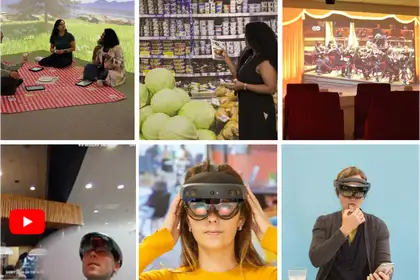
Images from the Feast Immersive Room in various purchase and consumption scenarios.
Providing surety of consumer acceptance is the mission of the Food Experience and Sensory Testing (Feast) Laboratory, located on Te Kunenga ki Pūrehuroa Massey University’s Manawatū campus and established by consumer testing expert and Fonterra Riddet Chair in Consumer and Sensory Science Professor Joanne Hort.
Consumer testing is a science with its own dialect and ways of quantifying the degree to which consumers ‘like’ or ‘don’t like’ a food or drink, such as the nine-point hedonic liking scale that is used globally to test consumer acceptance.
Understanding how people respond emotionally to food is even more important when predicting food choices, but Professor Hort says this type of testing is often overlooked.
“Unfortunately, many small, under-resourced companies often cut corners in their drive to get their products to market. Thorough market pre-testing is not cheap, but it’s a lot cheaper than the cost of failure after a product is launched.”
In the world of consumer preferences, our brains process a wide array of different sensory experiences – crunchy, salty, chewy, spicy and many more – resulting in simple judgements: whether we like something, if we want it and ultimately, whether we’ll buy it.
Other important factors include preconceived ideas about how healthy products are and previous experiences with similar products. For example, an individual might approach a plant-based ice-cream or oat milk differently due to preconceived ideas and expectations after a lifetime of consuming dairy.
“A lot of plant-based products are failing simply because they don’t taste very good. Ultimately, the vast majority of consumers will not buy food that doesn’t taste good, even if they have a strong commitment to reducing their consumption of animal products for health reasons or otherwise,” Professor Hort says.
There’s also a very powerful effect of place or social context on emotional response, appetite and enjoyment to consider. A simple ‘spag bol’ can be an everyday family meal eaten in a rush around the kitchen table, or an exotic meal to remember on holiday in the ambience of a red-velvet-interior Florentine restaurant, complete with serenading accordion player.
Either setting can now be replicated in Feast’s new, state-of-the-art, 360-degree digital immersion room. While they can’t necessarily promise a live Florentine accordion player, they have the ability to add in relevant props and aromas to the virtual environment.
For example, survey participants can sample and compare different ice creams on a summer’s day at Foxton Beach, with seagulls flying and screeching overhead, immersed in the sound of the surf and the ambient aroma of salt and seaweed while surveying the scene from a comfortable beach chair.

Feast's immersive beach environment, complete with sea aroma and sounds of waves crashing a shore.
The idea is to get as close to the real situation where the product would be consumed to ensure the survey results are as reliable as possible. Traditional testing booths or central location tests, which involve participants gathering at individual tables or booths together, do not have what is referred to as ecological validity and could be misleading.
Professor Hort was awarded a Catalyst Grant from the Ministry of Business, Innovation and Employment in an effort to support innovative food industries, providing the opportunity to apply digital immersion alongside traditional tasting booths and central location testing when evaluating plant-based meat alternative products. The resulting research showed consumer response to the same product often differed between traditional and digital contexts.
Along with her colleague Dr Caroline Giezenaar, Professor Hort also reviewed international research that directly compared results from the two methods. From the 21 studies they reviewed, digital immersion provided more accurate results overall, as consumer emotional responses were shown to be closer to real-life in immersive environments. Consumer engagement and reliability also increased compared to testing in traditional booths. However, some results were conflicting and more research is required to fully understand the benefits of digital immersive approaches before drawing firm conclusions.
Professor Hort says immersive digital techniques will become a necessary tool to generate more reliable insights into consumer liking and emotional response, but consumer testing remains a must. She hopes to convince the food industry of this, especially the small to medium enterprises where this form of testing is not traditionally part of the product rollout process.
“This may be an area where the government can provide further strategic support for food industry innovation,” Professor Hort says.
This work was funded by a New Zealand Ministry of Business and Education (MBIE) Catalyst Grant (MAUX2001).
Related news
To cultivate meat...or not to cultivate meat?
What’s at stake? Professor Joanne Hort tests the New Zealand market.

New research sheds light on Chinese consumers’ milk habits
Recent results from a New Zealand government-funded Riddet Institute research programme, NZ Milks Mean More, has provided valuable insights into dairy consumption in China.

Pop the bottle: turning green into gold for Kiwi winemakers
Turning wine grapes destined to rot on the ground into value-added products is the focus of a new research project led by Dr Amanda Dupas de Matos, Consumer Sensory Researcher in the Food Experience and Sensory Tasting laboratory , aimed at helping winemakers reduce the amount of grapes going to waste.
